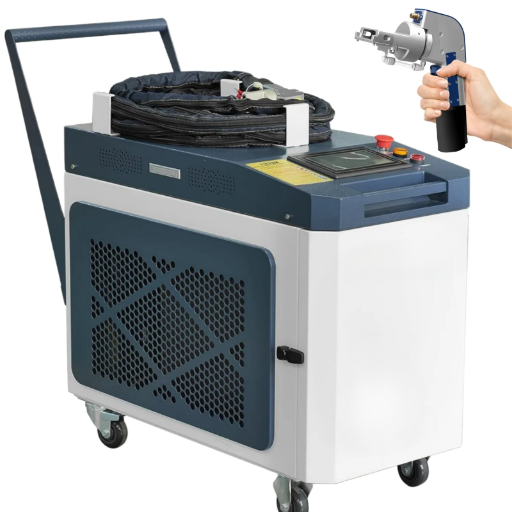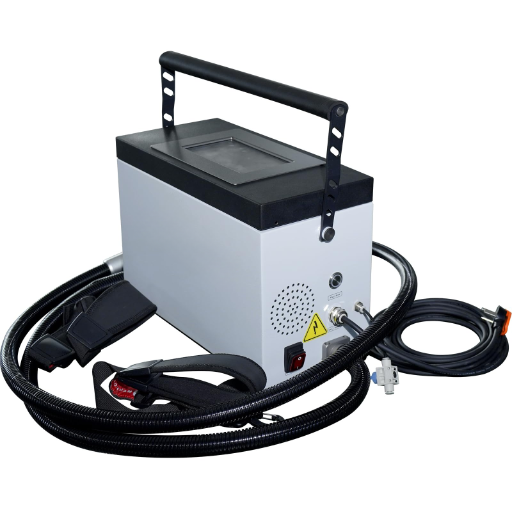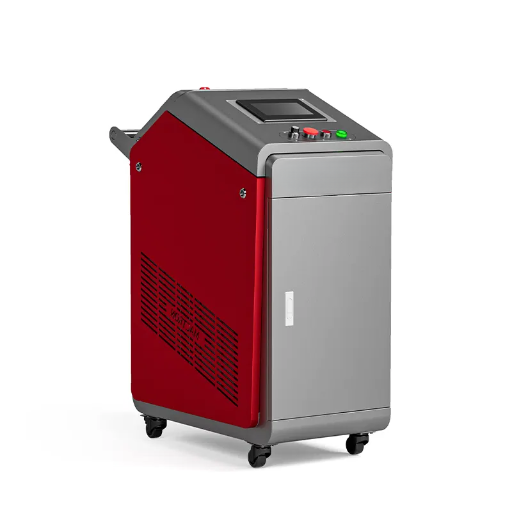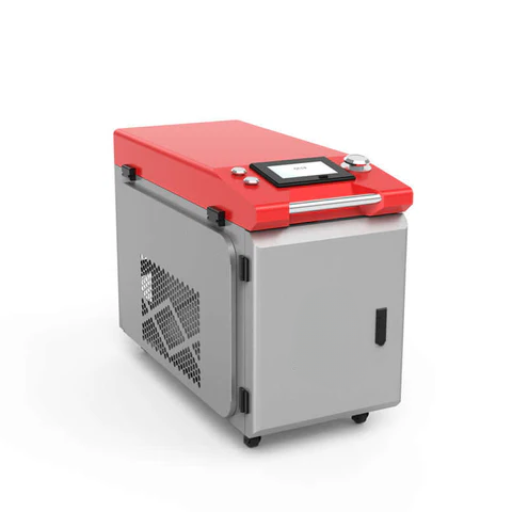Rust and stubborn contaminants can accumulate on equipment, vehicles, and components, leading to expensive damage. This is where fiber laser cleaning machines come in—this new technology is drastically changing how different industries deal with cleaning and restoration. In this blog post, we will explore everything you need to know about fiber laser cleaning machines, from their highly sophisticated rust cleaning capabilities to their multi-use functions. From businesses looking for effective precision cleaning solutions to individuals interested in new industrial innovations, find out how this technology is revolutionizing cleaning. Fiber laser cleaning machines are quickly becoming the cleaning workhorse of industry, so prepare to learn about their science, benefits, and myriad possible use cases.
What is Laser Cleaning and How Does it Work?

Laser cleaning is the advanced technique that involves the usage of highly accurate laser beams to obliterate any contaminant on a particular surface which may include dust, paint or even rust. The laser is set on the specified area and the unwanted mater vaporizes and breaks apart because of the intense light, not causing any harm to the surface beneath it. This method is extremely accurate and takes concern of nature because it does not make use of chemicals or any abrasive substances. Thus, this method is very reliable and safe for different uses.
Understanding Laser Cleaning Technology
Owing to its versatility, laser cleaning is considered one of the most advanced types of cleaning technology. Laser cleaning surpasses other cleaning technologies with its precision and also, its ability to protect the surface being cleaned. It provides maximum efficiency while cleaning because only the dirt or contaminant gets removed without any damage to the surface, providing added value to the foe hardened surfaces. The absence of chemicals or abrasives make it ideal for industrial use, manufacturing, restorations and aerospace industry. In addition to this, it can be used on intricate or delicate structures where other cleaning methods are not only ineffective but cause damage and cleaning aids.
How Fiber Laser Cleaning Works
Laser cleaning, and specifically fiber laser cleaning, is based on laser ablation. In this process, strong laser pulses are applied to the surface of a material to remove contaminants or unwanted layers. The precision of the process is exceptional because of the control over the wavelength, energy density, and pulse duration—the parameters that can be manipulated. For instance, highly sensitive surfaces can be cleaned with short-pulsed and high-frequency lasers, as they use minimal thermal energy and preserve the surface features.
Studies have also shown that the efficiency of fiber laser cleaning is influenced by material, degree of contaminant layering, and the environment in which the process is performed. In an example, the laser cleaning process enhances the efficiency of contaminants removal up to 99.9% in rust removal and paint stripping processes while minimizing the waste products in comparison to chemical cleaning methods.
Moreover, this method stands out with its low energy usage. Recent reports indicate that modern fiber lasers have dramatically reduced power consumption with savings of up to 30% when compared to older models. This makes them a great option for many industries that need reliable and high-standard surface treatment because they are cheaper, eco-friendlier, and more sustainable. With these developments in laser technology, industries can tackle their cleaning requirements more effectively while meeting the needs for environmental and economic sustainability.
Uses in Rust Removal And Other Areas
I have witnessed the immense potential of fiber laser technology in precision and efficiency-based applications like rust removal. This method removes rust while protecting the base material from damage, all while eliminating the use of abrasive chemicals, making it safer and more environmentally friendly. Aside from rust removal, fiber lasers can also be used for stripping paint, degreasing, polishing, and restoring parts, proving their worth in many sectors. Such adaptability broadens the scope of innovative techniques for sustainable processes in surface enhancement operations.
How to Choose the Right Laser Cleaning Machine for Your Needs?

- Material Type – Determine what surface you will be cleaning (metal, stone, or composite) to ensure compatibility with your work.
- Power Requirements – Choose a machine with a laser power suited to the intensity of cleaning needed. Delicate surfaces require lower power, while more heavily rusted surfaces or coatings require higher power.
- Portability – Decide whether portable or stationary machines fit your workspace and job requirements.
- Safety Features – Make sure the machine is equipped with protective housing and emergency stop measures to guarantee safety.
- Budget and Cost Effectivity – Balance upfront costs with long-term efficiency to determine what works best for your budget.
Evaluating Different Laser Cleaning Systems
- Cleaning Precision – When it comes to different laser cleaning systems, power comes from lasers and nowadays range from 20W to 2000W. A household-level laser that has 100 W is enough for moderate rust cleaning, while industrial ones above 1000W blast thick contaiminants with speed far more than anything else out there.
- Cleaning Speed – Compared to other methods, laser systems have advanced cleaning speed with top of the line systems achieving cleaning speeds of 60m²/h on large areas, making it ideal for use in high-volume industrial applications.
- System Efficiency– Consider power consumption a primary metric. Some of the newer fiber laser systems have energy efficiency claims above 30%, which decreases energy usage and costs over time.
- Lifespan and Maintenance – The estimated life span for fiber laser cleaning technologies is between 50,000 to 100,000 working hours, which decreases the frequency of servicing and lowers downtimes in busy working environments.
- Material Compatibility – These new cutting edge laser systems have been integrated with advanced configuration options that enable them to work effectively on a wider range of materials including steel, aluminum, brass, and even softer glass or composite materials. Operators can adjust parameters to optimize outcomes while preserving the integrity of the base material.
Key Features of a Fiber Laser Cleaning Machine
- High Precision Cleaning – Fiber laser cleaning machines are known to perform with exceptional accuracy, making them suitable for precise cleaning tasks, as they are careful not to abrade or distort features. These machines can adjust their laser power from 50W to over 2000W, making them capable of light rust removal as well as deep-surface cleaning and maintenance, thus versatile for all industries.
- Environment Friendly – Using a fiber laser for cleaning technology provides an eco-friendly solution. Many industrial sectors like cleaning, automotive, and shipbuilding need chemicals for cleaning, which are catastrophic for the environment. With fiber laser cleaning, there is no waste produced in any forms, neither is there any harmful emissions. Supplementary, Industrial cleaning emissions can be decreased by a whopping 90% with the use of the device, as scientisrs found out recently.
- Energy Efficiency- It is a laser cleaning innovation that saves industrial operational power expenditures. The most recent models are equipped with features that save on power consumption by up to 30% compared to previous models. Aside from the savings features, operationiong consumes lesser power compared to results achieved all increases peak performance during operation. This means operational costs for these industrial sectors reduces significantly.
- Wide Applications – All these capabilities exhibited by the cleaning technology increases it reliability and makes it suitable for varied applications. From research and data, it is evident that cleaning lasers have great usage in diverse fields and sectors like automotive, restoration, shipbuilding and many more. One application worthy mentioning, their application in automotive for paint removal to improve workflow reliability is well documented. They also use fiber lasers to improve handling in production lines and save about 25% of time and work needed.
- Automation – Laser cleaning models these days have automation features that allow them to operate independently without the need for human supervision. Their automatic feature enables shutting off the device after it is done with its function. An array of operator adjustment allow them to set safety controls like automatic shutoff among others. Once integrated with automated systems, tasks impractical for manual supervision become more efficiently handled without supervision.
Things to Keep in Mind for Industrial Usage
When considering the use of laser cleaning, industrial applications must focus on certain operational parameters and benchmarks. There are new researches which report that rasers can clean wrought surfaces with an efficiency as high as 99.9 percent for rust, paint, and grime removal without inflicting any damage to the underlying material. This level of accuracy is advantageous in parts preservation industries such as aerospace and automotive manufacturing nal industry.
In addition, laser cleaning systems can readily be utilized on other materials like steel and aluminum as composites which make it adaptable for multiple industries. According to Google Trends, laser cleaning technology is emerging rapidly in several industries located in Europe and North America with the global cleaning market estimated to grow at 7.8% annually until 2030. The figures reflect the economic movement toward effective and green cleaning solutions tailored to the needs of modern society.
Use of laser cleaning integrated with production processes improves company profitability, reduces process time and revision maintenance while claiming leadership in eco-technology.
What are the Benefits of Using a Fiber Laser for Cleaning?

- Precision: Cleaning using fiber lasers achieves high precision which allows specific areas to be targeted without damaging surrounding areas.
- Eco-Friendly: There is no need to use chemicals or abrasives which improves the environmental impact.
- Low Maintenance: When compared to other cleaning methods, fiber lasers have a longer lifespan and require less maintenance.
- Efficiency: They are ideal for different industries as they provide fast, reliable, and consistent results.
- Versatility: They can be used to clean metals, glass, stones and other materials.
Advantages Over Traditional Cleaning Methods
| eature | Traditional Cleaning Methods | Fiber Laser Cleaning |
|---|---|---|
| Effectiveness | May require multiple cycles to achieve results | Removes contaminants precisely in a single pass |
| Environmental Impact | Often involves harmful chemicals and waste | Eco-friendly with no chemicals or abrasives |
| Cost | High recurring costs for chemicals and tools | Low long-term cost due to minimal maintenance |
| Versatility | Limited to specific materials or surfaces | Effective on metals, glass, stone, and more |
| Maintenance | Frequent consumables replacement required | Minimal maintenance with longer system lifespan |
| Speed | Slower process, often labor-intensive | Faster cleaning time and higher productivity |
Effectiveness of Fiber Lasers: Rust and Paint Removal
Fiber lasers are highly efficient at rust and paint removal for many industries. These lasers are capable of precisely拆除 rust or paint in layers per the industry requirements without harming the material beneath. Modern systems often operate with cleaning rates of up 50 cm² and speed up efficiency in industrial settings.
Recent studies highlight the energy efficiency of fiber laser systems, especially when compared with blast methods. Contrary to traditional blasting methods, laser cleaning requires 50% less energy to get the same result. Furthermore, fiber lasers do not require sand, or harsh chemicals and thus will significantly lower operational costs over time.
This technology excels in automotive restoration, ship maintenance, precision tooling and more. Through real-time monitoring, adjustable parameters, and user friendly interfaces, fiber laser systems offer maximum performance while upholding safety requirements even when working on fragile or complex surfaces.
Advantages of Non-Contact Cleaning
Laser cleaning of non-contact type makes use of fiber lasers. unlike other methods, it is considered cleaner, more efficient, faster as well as more precise. In non-contact cleaning, specialized lasers first target the surface to be cleansed, vaporizing rust, paint or other kinds of contaminants sitting on the surface. This method alllows exess materials/ has no abrasive techniques and chemical solvents, resulting in less destructive waste processes.
Particularly burnable wastes such as smoke have a place in the automotive industry, however, their performance and efficiency have increased in leaps and bounds. Cleaning speed with fiber laser systems was reported to be as high as 15–20 square meters per hour with traditional methods stagnating at lower figures. Manufacturing divisions also using fiber lasers for parts cleaning were captivated with the downtimes reduced by up to 90 percent. Lastly these systems are also very efficient through energy consumtion, operating over 1 kilowatt-hour of energy each hour. The results are cost effective and sustainibility.
Orders of magnitude different can be achieved with other cleaning technologies as. For instance, from delicate restoration of historical artifacts to heavy duty industrial cleaning Through the combination variant unconventional materials flexible settings can now be used, resulting in more precise cleansing of artifacts and other items.joined with powerful AI and IoT systems, lasers make use of real time analytics for more advanced cleaning and add optimized sensors as well.
How Does a Handheld Laser Cleaning Machine Perform?

Using a handheld laser cleaning machine is effective as a focused laser beam cleaning device since it can remove unwanted substances like rust, paints and residues. The laser cleaning machine is not only easy to operate, it provides precision cleaning while protecting the material underneath from any potential damage. It is, however, devoid of any inefficiency, eco-friendly and requires little maintenance which makes this machine applicable for even delicate tasks alongside industrial uses.
Laser Cleaning Solutions
The development of portable laser cleaning devices has transformed the methods of surface treatment because these offer a more flexible approach to cleaning coupled with ease of use. These machines are designed to be convenient and easy to carry as well as store and brought to various job sites or difficult areas. The ergonomic and lightweight construction of these devices makes them easy to handle without losing efficiency. These devices are able to deal with great tasks such as corrosion removal in industrial contexts to sensitive cleaning of historical monuments. Their far stronger adaptability to various cleaning tasks in comparison to traditional methods, alongside their precision and ease of operation make them indispensable in multiple sectors.
Working of a Handheld Fiber Laser Cleaner
Using a highly focused laser beam, handheld fiber laser cleaners clean surfaces by ablating stubborn contaminants such as oil, paint, rust, and residues. These devices utilize advanced fiber laser technology, which is highly efficient and consumes minimal energy. One of the core benefits of handheld fiber laser cleaners is the non-contact cleaning process, eliminating the chances of surface damage, which is common with abrasive cleaning techniques.
Recent breakthroughs claim that handheld fiber lasers can achieve cleaning speeds of 50 cm² per second, depending on the material and degree of contamination. Operators can adjust power and pulse settings to customize the cleaning intensity, providing control over the amount of material processed. Data highlights that fiber laser cleaners remove contaminants precisely within 1 micron ensuring unmatched precision and surface area fidelity.
Furthermore, the energy consumption of these devices is estimated to be 600-1000W while in use, demonstrating remarkable energy efficiency. This further improves their “green” credentials when compared to other cleaning methods like sandblasting or chemical cleaning, which are notorious for hazardous byproducts or waste disposal difficulties. Additionally, these devices lower the operating costs throughout the lifespan of the device, which is usually 100,000 hours of operation before major servicing is needed, due to the low maintenance costs associated with handheld fiber lasers. Alongside providing handheld fiber laser cleaners with unparalleled adaptability in various sectors, including aerospace, automotive, and manufacturing, still deriving the versatility of everything else mentioned earlier, marks it as a revolutionary technology are unprecedented and unmatched.
Where to Find a Laser Cleaning Machine for Sale?

If you’re on the hunt for a laser cleaning machine for sale, consider looking at reputable manufacturers and distributors like Laser Photonics, CleanTech, and Rustek. These companies offer industrial and handheld laser cleaning systems designed to fit many uses. For more information on laser cleaning machines specifications, pricing, or how to purchase one, it is best to visit these companies’ sales websites and contact the representatives directly.
Important Features When Selecting a Laser Cleaning Machine 220v
In order to meet the intended application for a 220v laser cleaning machine, it is critical to pay attention to multiple aspects to ensure suitability and effectiveness. One important detail is the outgoing power of the machine. The output power on cleaning machines ranges from 50 watts to 2000 watts and the required power will depend on what material is being cleaned and what type and how much dirt there is. As an example, lower power systems (50-100W) are best for delicate surfaces while higher power systems (1,000W or more) are better suited for heavy-duty industrial work like rust or paint removal.
Moreover, the class of laser source, like fiber lasers or Nd:YAG lasers, has a great influence in the effectiveness and cleanness of the cleaning process. Fiber lasers, for one, are greatly preferred due to their ruggedness, ease of maintenance, and energy efficiency. Also, other crucial aspects to be considered are repetition rate and beam quality since they determine the overall precision and consistency during the cleaning process.
Also, considering the machine’s weight and portability is beneficial, especially for handheld models, as this influences ease of operation. These machines should be lightweight yet sturdy to enable effortless maneuvering during operations without compromising the performance of the machine. During operation the user should be protected by the machine’s safety features such as control dust extraction systems, remote controls, and interlocks.
Finally, estimating the average price of laser cleaning machines is very important. As per the latest information, entry level handheld models are assumed to be within 10 thousand dollar range. On the other hand, high capable industrial systems exceed fifty thousand dollars. Comparing specifications, reviewing them alongside warranties and different vendors ensures you’re getting the most value of the many available options.
Main Providers of 2000w Laser Cleaner
- IPG Photonics – They are well known for crafting industrial-grade, high-quality laser cleaning systems that provide and withstand the test of time performance and dependability.
- Laser Photonics – They offer multifunctional 2000w laser cleaners that are applicable in paint and rust removal.
- CleanTech – Focuses on user-friendly and efficient designs within the filed of advanced laser cleaning technology.
- P-Laser – Provides high-performance 2000w systems within a compact and easy to operate form factor.
- Han’s Laser – A leading supplier of laser cleaning machines, including versatile high-power industrial units.
Reference sources
1.Rapid classification of steel via a modified support vector machine algorithm based on portable fiber-optic laser-induced breakdown spectroscopy
- Authors: M. Yuan et al.
- Publication Date: December 1, 2021
- Summary: This study presents a method for the rapid classification of steel using a portable fiber-optic laser-induced breakdown spectroscopy (FO-LIBS) system. The authors developed a model combining principal components analysis (PCA) with a support vector machine (SVM) to classify 14 types of special steel samples based on their spectral data. The results showed that the PCA-SVM model achieved a recognition accuracy of 100% when 13 principal components were used, indicating the effectiveness of FO-LIBS in industrial applications for online detection and classification of materials.
- Methodology: The study utilized PCA to reduce the dimensionality of the spectral data and SVM for classification. The spectral data were collected from various steel samples, and the model’s performance was evaluated based on its classification accuracy(Yuan et al., 2021, pp. 124114–124114).
2.Fiber Coupled High Power Nd:Yag Laser for Nondestructive Laser Cleaning
- Authors: Xiaolei Wang et al.
- Publication Date: August 3, 2023
- Summary: This research introduces a fiber-coupled high-power Nd:YAG laser system designed for laser cleaning applications. The system achieved a maximum average output power of 783 W and demonstrated effective nondestructive cleaning of thermal control coatings. The study highlights the system’s portability and efficiency compared to existing commercial laser cleaning machines, making it suitable for various industrial cleaning tasks.
- Methodology: The authors developed a prototype laser cleaning machine and conducted experiments to evaluate its cleaning effectiveness on different surfaces. The performance was assessed based on the output power and cleaning results, comparing it with existing technologies(Wang et al., 2023).
3.Testing of a new Yb:YAG fiber laser system for the removal of graphic vandalism from marble
- Authors: Amelia Suzuki et al.
- Publication Date: June 20, 2023
- Summary: This study investigates the use of a Yb:YAG fiber laser system for removing graffiti from marble surfaces. The research demonstrates the laser’s effectiveness in cleaning large areas while maintaining portability. The findings indicate that the laser cleaning process can effectively remove various types of paint while minimizing damage to the underlying marble.
- Methodology: The authors employed a multimodal approach to evaluate the cleaning process, including optical microscopy, Fourier Transform Infrared spectroscopy, and thermal monitoring. The study assessed the impact of different laser settings on the cleaning efficiency and surface integrity(Suzuki et al., 2023, pp. 1–20).
4.Top Fiber Laser Cleaning Machine Manufacturer and Supplier in China
Frequently Asked Questions (FAQs)
Q: What is a portable fiber laser cleaning machine?
A: A portable fiber laser cleaning machine is a device that utilizes laser technology to ultrasonically clean surfaces by removing rust, paint, and oxide from metals. Its form factor makes it easy to carry, as well as versatile for many different applications.
Q: How does laser rust removal work?
A: Laser rust removal involves the application of laser pulses that rusts absorbs. The product of the laser is aimed to increase the temperature, which is achieved very rapidly in the oxidation layer for example rust. This efficiently vaporizes the layer without damaging the underlying metal component.
Q: What are the advantages of using a handheld laser rust removal tool?
A: Handheld laser rust remover tools possess other benefits such as spatial accuracy a degree of precision virtually instant access no base damage indiscriminate cleaning thrust and concealment chemical free non abrasive scrubbing unlike rough cleaning tools abrasive and abrasive free.
Q: Can a 1500w pulsed laser be used for coating removal?
A: Especially with regards to coating removal, a 1500w pulsed laser can be useful. It can strip various coatings from metals without damages and provides surface cleaning that is required prior to work placed on laser welding.
Q: What types of surfaces can a portable handheld laser cleaner be used on?
A: A portable handheld laser cleaner can be utilized for various metals such as steel, aluminum, and copper for purposes like rust removal from metal surfaces and oxide cleaning.
Q: Is cleaning with a laser safe for people operating the machine?
A: Yes, laser cleaning is safe as long as proper laser safety precautions are in place such as the use of laser protective glasses and proper ventilation of the working space.
Q: How does a pulsed laser cleaning machine differ from a continuous laser?
A: A hand-held or portable laser cleaning machine using a pulse technique has bursts of energy as it emits laser which is more effective to remove thin layer of rust or coatings. The opposite is true with continuous laser where a steady beam is outputted which may be ideal in some cleaning situations.
Q: What is the function of the laser cleaning head?
A: The laser cleaning head focuses and places the laser beam on the target area. It is one of the main parts of the laser cleaning machine with the responsibility dealing with the cleaning of a surface.
Q: Can a laser cleaning machine 110-220v air-cooled be used for industrial applications?
A: Yes, a laser cleaning machine 110-220v air-cooled is suitable for an array of industrial processes including laser rusting removal, oxide removal, and surface cleaning. It can be used in multiple environments.
Q: How does laser cleaning compare to mechanical cleaning methods?
A: Compared to mechanical cleaning, laser cleaning is more accurate and less harmful. There are no consumables such as abrasives or chemicals needed, and it can eliminate rust and coatings while keeping the metal surface intact.

